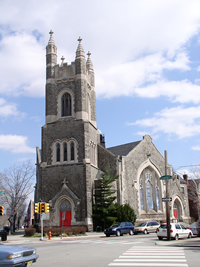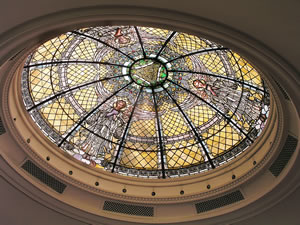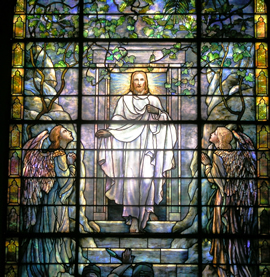
The first in the series turns to Philadelphia, Pennsylvania, where Partners for Sacred Places helped turn the once vacant and neglected Calvary United Methodist Church into the home of five active congregations and a range of secular activities. A non-profit, non-sectarian organization, Partners for Sacred Places is dedicated to the stewardship and active community use of older religious properties in the U.S.
Places of Faith: Successful Adaptations
Case Study 1
Calvary United Methodist Church
Philadelphia, Pennsylvania
By: Nicole Sammut
Brief History 
Calvary United Methodist Church is located on 48th Street and Baltimore Avenue in West Philadelphia. The church was built in 1906-07 by New York architects William R. Brown, George Curtis Gillespie, and Henry Clay Carrell. Although the exterior of the building is English Gothic, the interior is atypical. In addition to Calvary’s collection of stained glass windows—which includes two immense Tiffany windows in the sanctuary—a massive stained glass dome is unique to the church.
Changing demographics in the 1970s left a dwindling congregation unable to support the escalating maintenance costs, and the church fell into disrepair. By the 1990s, the extensive maintenance needs had evolved into structural issues and the congregation decided to sell. Without a buyer, the church lay vacant for a number of years. The congregation eventually reduced the asking price and attempted to sell the stained glass windows and dome separately.
The Community Steps In
Determined to keep the stained glass windows at Calvary United Methodist Church, the community approached the congregation to help find alternatives that might secure the landmark building’s future. With the help of the United Methodist Bishop, the stained glass dome was returned to Calvary while congregational members and community leaders sought out possible new uses for the site. The goal was to find ways of generating the revenue needed to keep Calvary functioning as a place of worship. As it happened, the community was looking for an activity centre and a space for the cultural arts.
 Support and Funding
Support and Funding
Funding for the restoration and conversion projects at Calvary was spearheaded by Partners for Sacred Places, a national, non-sectarian, non-profit organization committed to helping congregations and their communities sustain and actively use older and historic places of faith. With New Dollars/New Partners—a program designed to generate financial support from sources outside the religious community—funds have been successfully raised to help maintain and restore threatened religious buildings, ensuring their longevity. Robert Jaeger, a co-director of Partners for Sacred Places, assisted in establishing the Friends of Calvary, a group of community members committed to finding a solution that would preserve the building. After lengthy deliberations, they agreed that the space could serve as both a sacred place and a venue for secular events and a performing arts centre.
A separate non-profit organization, Calvary Center for Culture and Community (CCCC), was created by Calvary United Methodist Church to not only develop programs, but fundraise to rejuvenate the building. Its success has resulted in the masonry being repaired, the gables restored, the attic insulated, and the sanctuary transformed from a crumbling storeroom to a vibrant theatre space.
The Future
Calvary United Methodist Church and Center for Culture and Community is an active and fully integrated building within the community. It is not only home to four Christian congregations and the Kol Tzedek synagogue, but a space for secular activities. Many organizations have established permanent offices within Calvary while a number of theatre companies have identified the building as the primary location for the arts. Today, Calvary stands as a model example for urban churches. The space still functions as a sacred space, yet it is enriched from the successful community and arts programs that are integrated into this multipurpose facility.
The CCCC continues to raise money with a $2 million restoration campaign under way.
The National Trust would like to thank Masters in Heritage Conservation candidate Nicole Sammut for her contribution.
